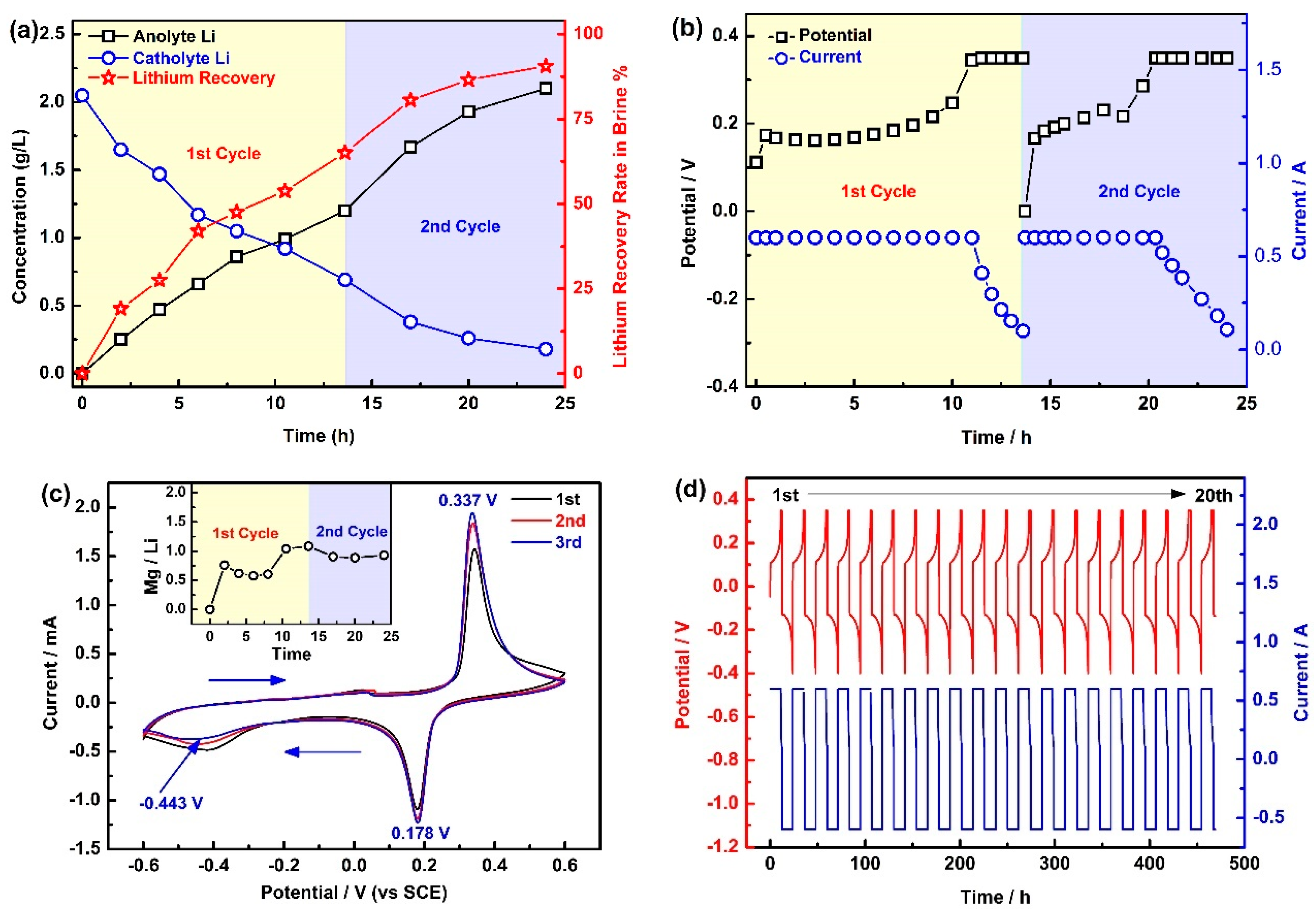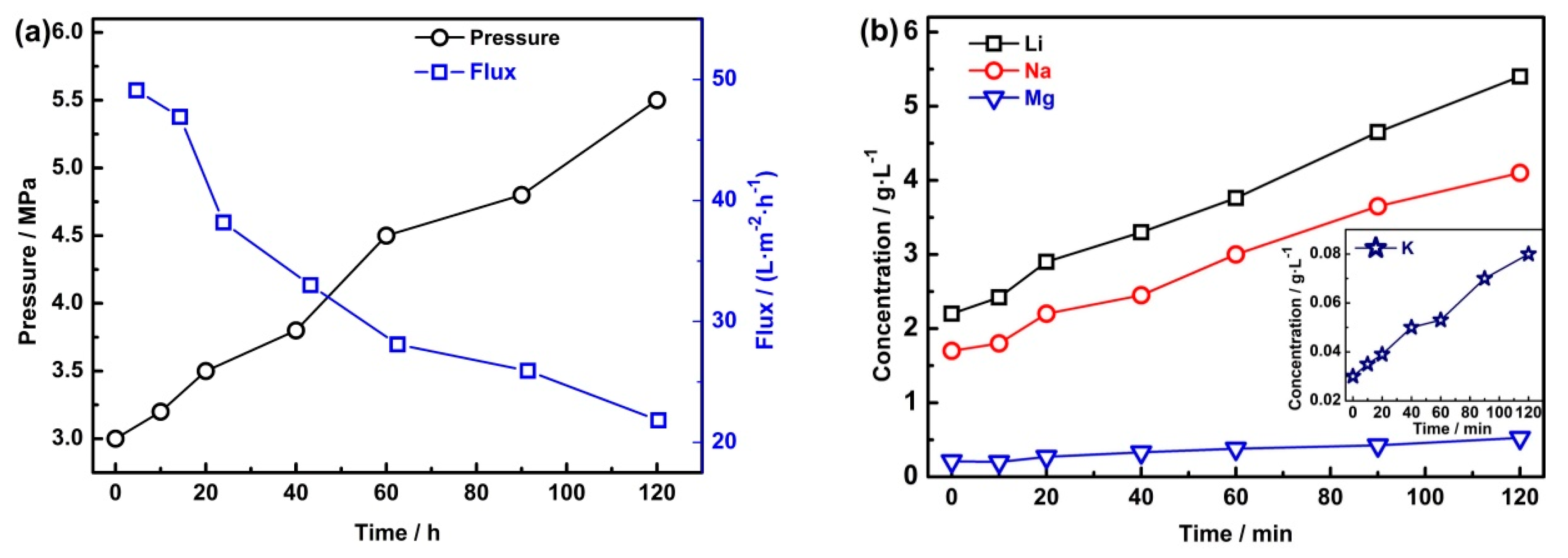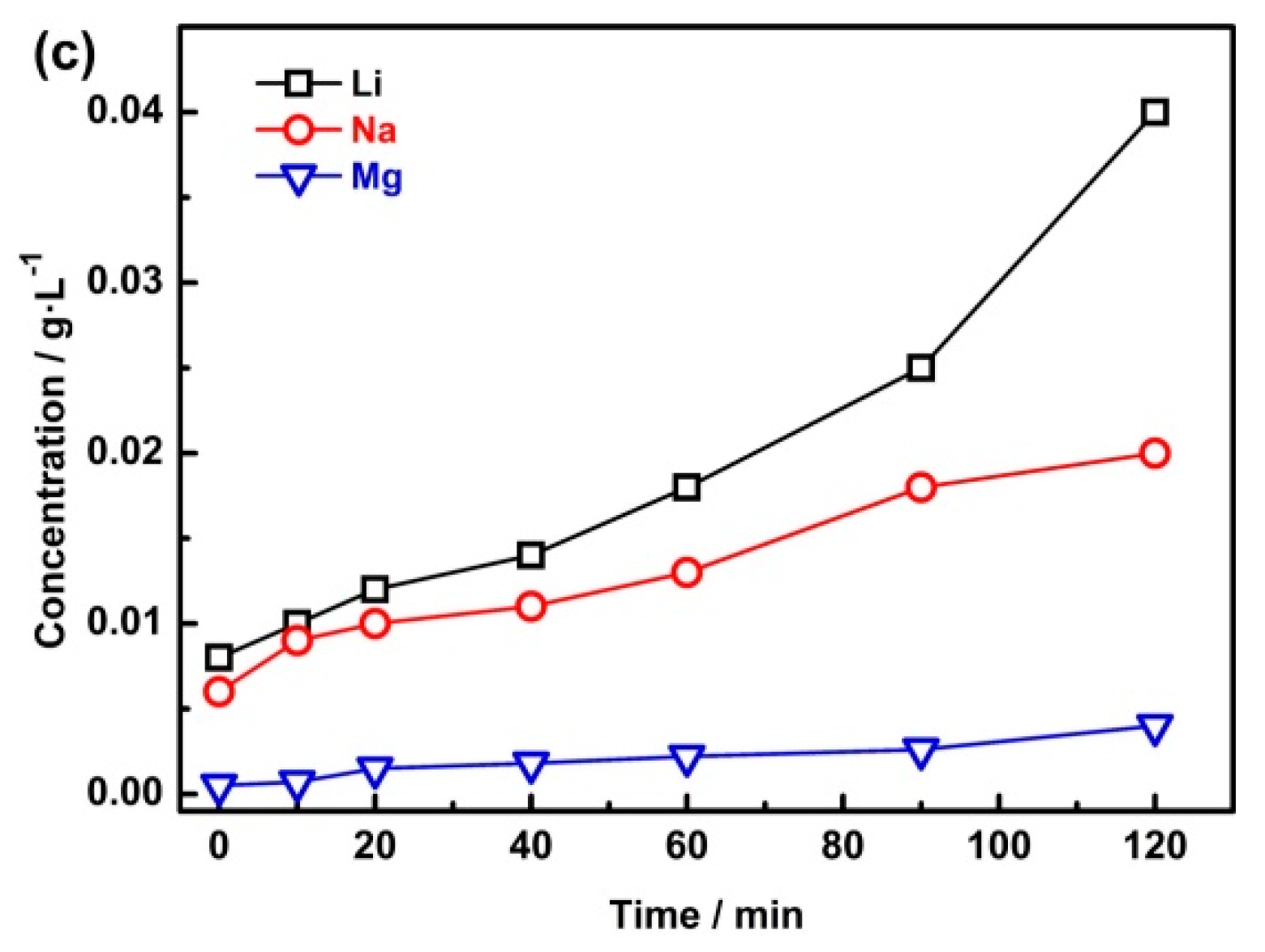In order to precipitate lithium carbonate, the lithium-riched anolyte needs to be deeply purified and concentrated. In this paper, NF and RO were used for deep purifying of the divalent ions and concentrating of the penetrating fluid, respectively. Both NF and RO were carried out only once and the corresponding results of the NF and RO processes are shown in below.
3.2.1. NF Process
The corresponding experimental results are shown in
Figure 3 and
Table 3. As shown in
Figure 3a, the initial operation pressure of the nanofiltration was 2.0 MPa. The water flux decreases slowly from the initial 52 L·m
−2·h
−1 to 50.5 L·m
−2·h
−1 at first, and then rapidly declines from 50.5 L·m
−2·h
−1 to 31.6 L·m
−2·h
−1. Inversely, the operation pressure increases at first and then rapidly reaches 8 MPa. There are three main reasons for this phenomenon: (1) the increase of the osmotic pressure in the retentate solution; (2) the precipitation of the salts on the surface of the NF membrane; and (3) the compaction of the NF membrane.
The concentration of the ions in the permeate flow and collected retentate during the NF process are shown in
Table 3 and
Figure 3b, respectively. From
Table 3, it can be seen that the conductivity increased slowly at the beginning of the initial stage (increased from 37.5 mS·cm
−1 to 52.0 mS·cm
−1). Subsequently, a significant increase followed after 90 min from the start of the NF, and the conductivity reached 108.2 mS·cm
−1. The temperature rose slowly throughout the experiments (from 24.7 °C to 27.5 °C), and the rise in water temperature comes from two aspects: (1) the mechanical friction of the high pressure pump produce a great deal of heat; and (2) the friction of the fluid and the pipe, which also generates heat. The flow rate of the entire NF process was kept at 16 L·min
−1. There was no significant change in the concentration of monovalent ions such as Li
+, Na
+, and K
+, while divalent ions such as Mg
2+, Ca
2+, and SO
42− are abundantly enriched in the retentate solution. Moreover, the concentration of Mg
2+, Ca
2+, and SO
42− at the end of the NF process reached 18.23 g·L
−1, 0.02 g·L
−1, and 2.41 g·L
−1, respectively. It can be found that Mg
2+, Ca
2+, and SO
42− were concentrated 9.3 times, 5 times, and 9.1 times, respectively. The concentrated times of Ca
2+ were lower than those of Mg
2+ and SO
42−. Notably, the main anion in the collected retentate is Cl
−, which was rejected to maintain the electrical neutrality of the collected retentate.
As shown in
Figure 3b, the concentration of Li
+, Na
+, Mg
2+, and K
+ in the permeate flow increased obviously, while the concentration of Ca
2+, and SO
42− is very low and can almost be ignored (Ca
2+ and SO
42− are 3.1 × 10
−4 g·L
−1 and 1.07 × 10
−3 g·L
−1 at the end of the NF process). Specifically, the concentration of Li
+ and Na
+ increased from 2 g·L
−1 to 2.54 g·L
−1 and 1.55 g·L
−1 to 1.97 g·L
−1, respectively. Moreover, the concentration of K
+ also increased slowly from 0.033 g·L
−1 to 0.041 g·L
−1. In contrast, the concentration of Mg
2+ increased sharply from 0.12 g·L
−1 to 0.86 g·L
−1. Combining the concentration of ions (Li
+, Na
+, and Mg
2+) in the collected retentate, it can be found that there is basically no interception of monovalent ions, while the interception rate of multivalent ions is very high. The reason for the higher rejection of Mg
2+ can be explained using Donnan exclusion. The concentration of counter ions (ions with charge opposite to the fixed charge in the membrane) in the membrane is higher than that in the bulk solution, while the concentration of homonymous ions in the membrane is lower than that in the bulk solution. The Donnan difference prevents the diffusion of homonymic ions from the bulk solution into the membrane. In order to maintain electrical neutrality, the counter ions are also trapped by the membrane. The coulomb repulsion of the multivalent ions is greater than that of the monovalent ions, which explains why the rejection of Mg
2+ is higher than that of Li
+ and Na
+.
The rejection rate of the divalent ions is shown in
Figure 3c. It can be seen that the rejection rates of SO
42− are higher than 99%, while the retention rates of magnesium gradually drop to 89.9%. Combining the data presented in
Figure 3b, it can be found that the concentration of Ca
2+ and SO
42− in the permeate flow can almost be ignored, which means that sulfate and calcium ions can hardly pass through the nanofiltration membrane. In order to determine whether there is precipitation in the NF process, the solubility of all chlorides and sulfates in the solution at 20 °C is listed, as shown in
Table 4.
According to the results provided by
Table 3 and
Table 4, all of the soluble salts that exist in the collected retentate are not saturated. Notably, there is 0.004 g·L
−1 Ca
2+ and 0.26 g·L
−1 SO
42− in the beginning of the NF, which results in 0.04 g·L
−1 Ca
2+ and 2.6 g·L
−1 SO
42− at an assumed retention of 100%, and the concentration of Ca
2+ and SO
42− has not reached the
Ksp of CaSO
4·2H
2O (the solubility of CaSO
4·2H
2O is 0.255 g at 20 °C, which means the
Ksp of CaSO
4·2H
2O is 2.2 × 10
−4) [
38]. Because of the retention of divalent ions by the NF membrane and the influence of the electric double layer, a large amount of divalent ions will be enriched on the surface of the NF membrane. When the sulfate and calcium in the bulk retentate solution have not reached the conditions for CaSO
4·H
2O precipitation, there is already CaSO
4·H
2O precipitation on the surface of the nanofiltration membrane. That is the reason the concentration of Ca
2+ in the bulk collected retentate is only 0.02 g·L
−1, as the feed solution has concentrated 10 times. Further, because the total amount of Ca
2+ is much lower than that of SO
42−, this results in the lower concentrated times of Ca
2+ than SO
42−. In order to reduce the membrane scaling caused by calcium sulfate precipitation, it is better to wash the membranes after the NF operation. By contrast, Mg
2+ can only be continuously accumulated in the collected retentate without precipitation, resulting in a higher concentration of Mg
2+ in the permeate flow. In other words, the more Mg
2+ that enters the permeate flow, the lower the retention rate of Mg
2+.
The separation factor of lithium and magnesium (SF
Li-Mg) and lithium recovery are shown in
Figure 3d. It can be seen that the SF
Li-Mg rose from 15.4 to 30.1 in the first 30 min, and then gradually decrease from 30.1 to 22.8 in the next 75 min. The increasing concentration of Mg
2+ in the collected retentate is unhelpful for the separation of lithium and magnesium. In addition, the lithium recovery increased almost linearly, and reached 91.6% at the end of the NF process. Noteworthily, the total salinity in the retentate liquid is too high, and the residual lithium cannot be directly recycled by NF, but this retentate liquid can be returned to the EID system to separate lithium and magnesium, which can reduce the waste of lithium.
The final compositions of the permeate flow produced by NF are shown in
Table 5. From
Table 5, it can be seen that the major cationic ions in the permeate flow are Li
+, Na
+, and Mg
2+, and the main anionic ion is Cl
−. The concentration of K
+ is only 0.03 g·L
−1, and other impurities such as Ca
2+ and SO
42− can almost be ignored.










